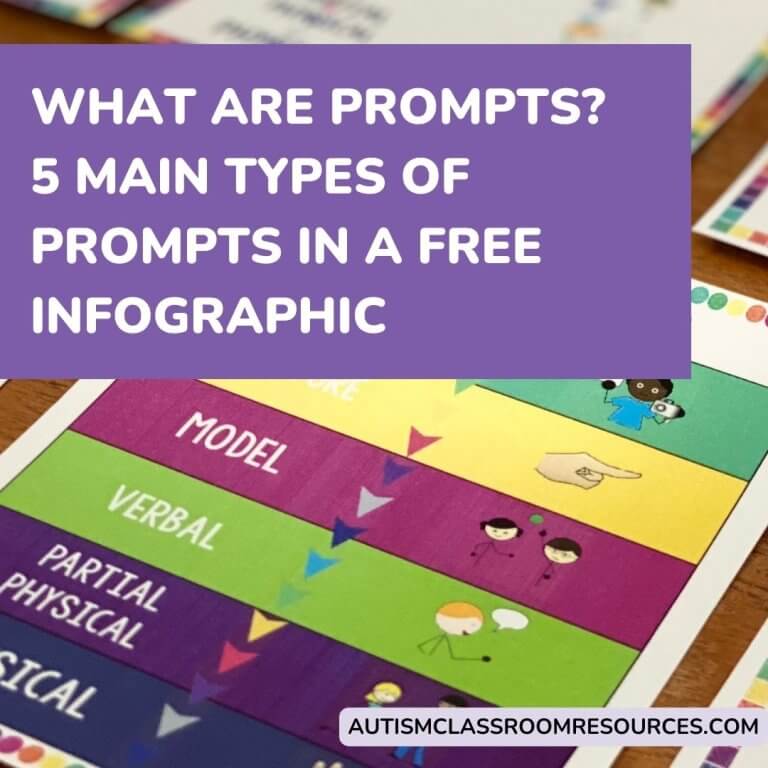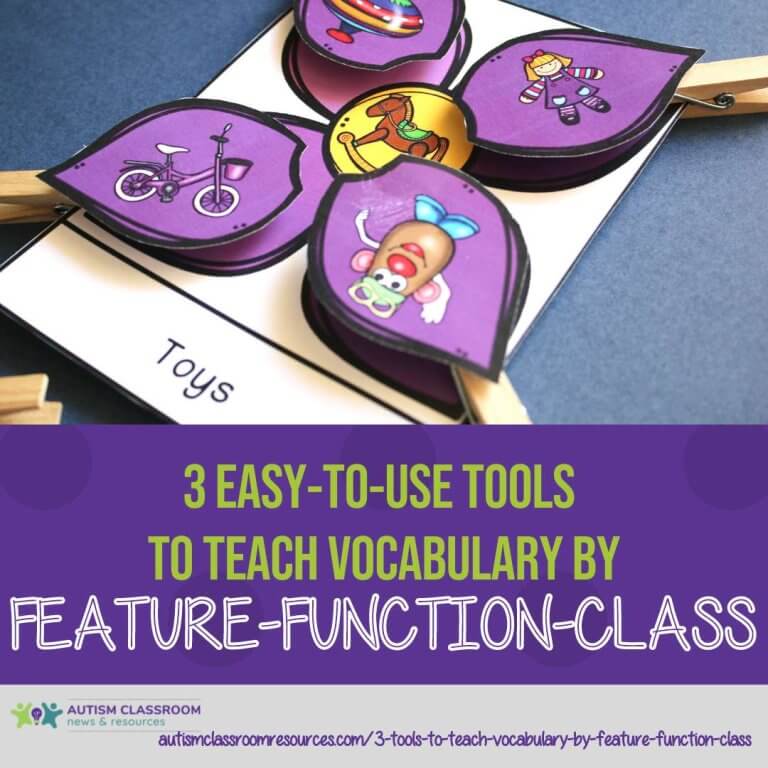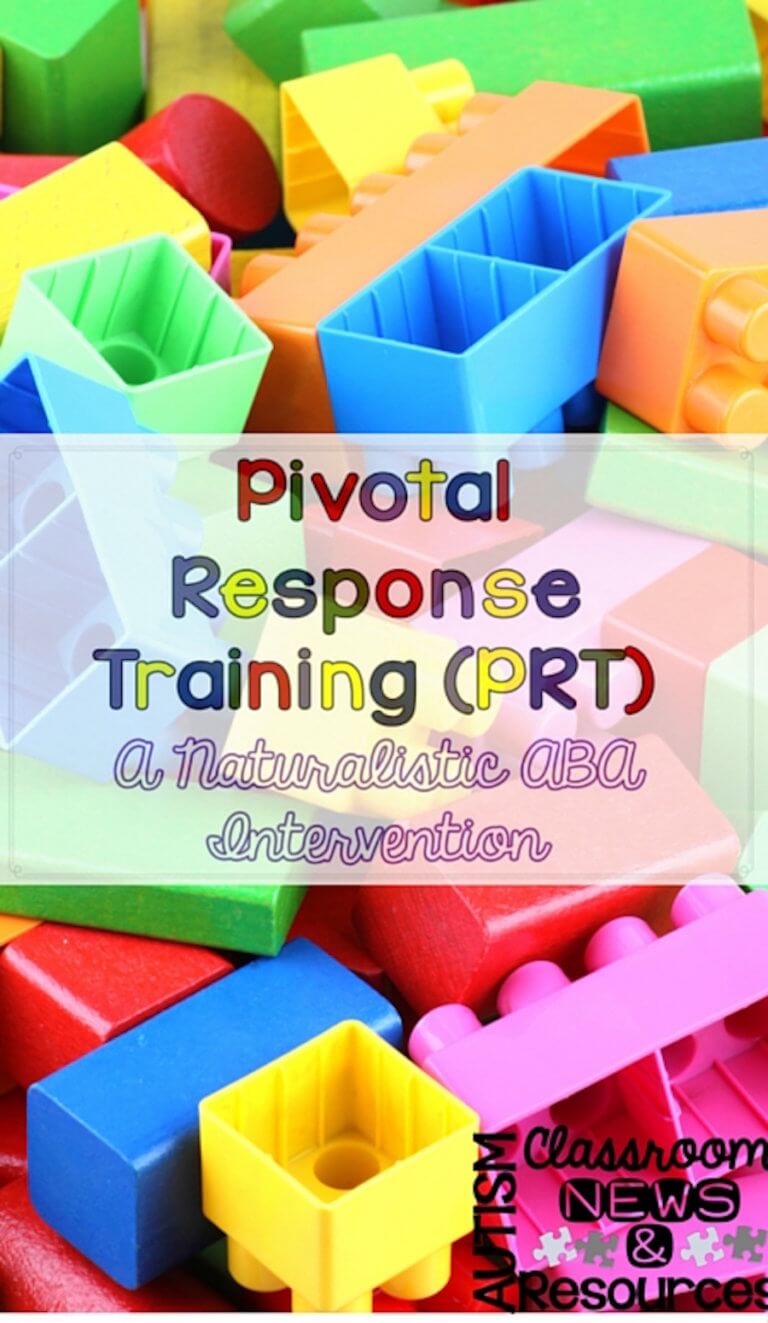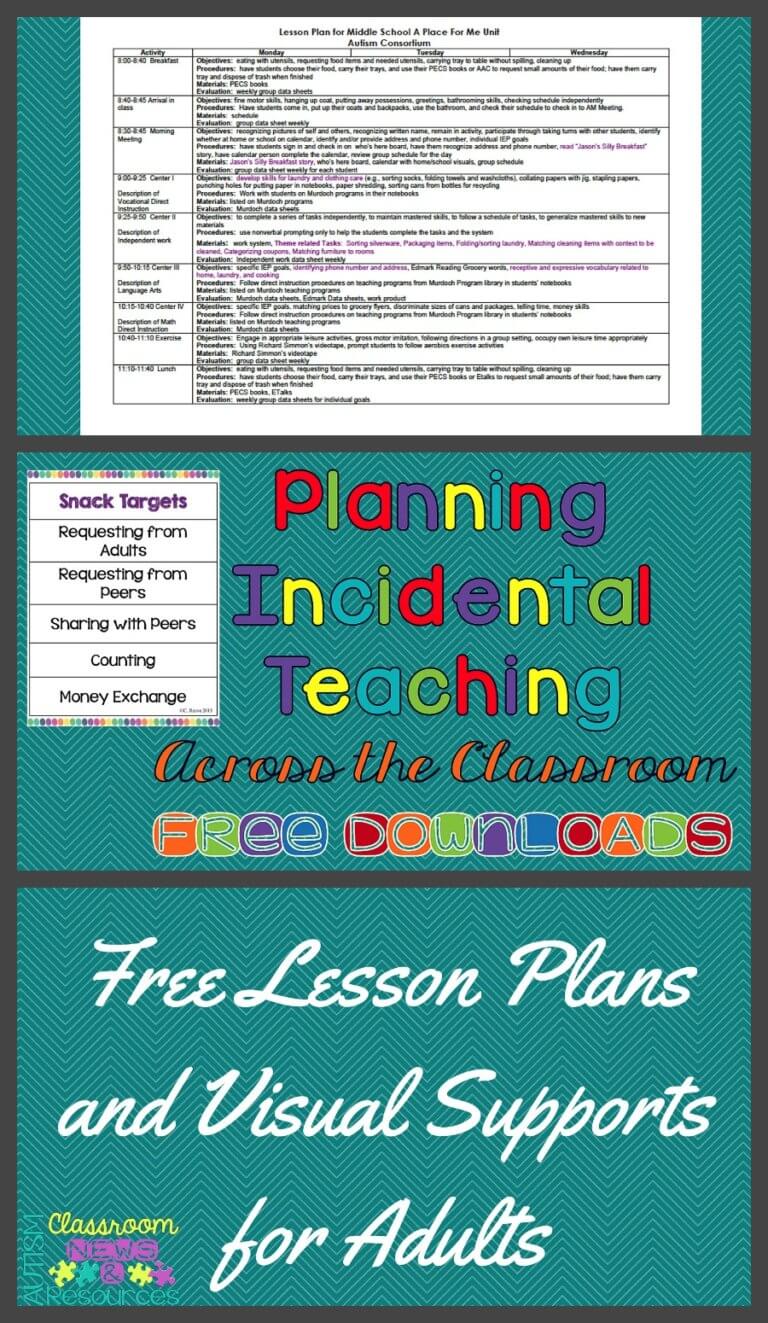Sharing is caring!
Keeping with the Thursday/Friday placement of series posts, today I want to share 5 easy ways to provide consequences for students’ responses that can significantly improve your students’ learning in discrete trials (and overall). Throughout the Effective ABA Instructional Strategies Series, I have alluded to the use of reinforcers to teach new skills in discrete trials. Essentially, we use reinforcers to try to increase correct responses in discrete trials and ABA instruction in general. However, if we use them ineffectively we run the risk of reinforcing the wrong thing, not reinforcing what we wanted to, or just reinforcing badly so that the skill does not improve.
The reinforc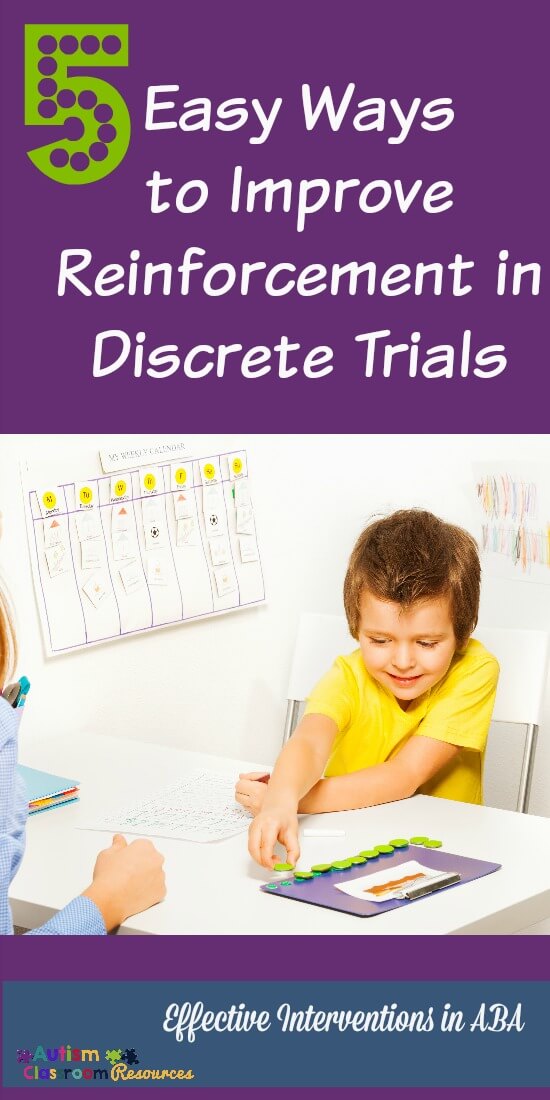 er (or consequence) is the most important part of the 3-step contingency of a discrete trial. It is coming into contact with the reinforcer that changes the behavior and therefore teaches the skill. Behaviorally consequences either increase (by reinforcing) or decrease (by extinction or punishment) a behavior or they could have no impact on the behavior in which case the consequence would not be a reinforcer or a punisher. Reinforcement (and punishment) are defined based on their effect on the behavior. If the behavior does not increase, it’s not a reinforcer. I have had kids who were reinforced by giving a spoon, by giving a piece of tape, and by ice–these are not items that would reinforce my behavior, but it worked for them. For more on that topic and ways to keep your reinforcers fresh (and figure out what might be a reinforcer for the behavior you are trying to teach), check out THIS POST and this post. Not using something that actually serves as a reinforcer (i.e., the behavior it follows increases) is probably the most common error I’ve seen. So, step 1 is always to make sure that what you are using and calling a reinforcer is really reinforcing for the individual. If you have assessed your consequences to see if they are reinforcing but progress isn’t moving as fast as you would like, then there may be something else at play that we need to consider. Here are 5 ways that we can make sure that how we provide the consequences for discrete trials are the most effective they can be.
er (or consequence) is the most important part of the 3-step contingency of a discrete trial. It is coming into contact with the reinforcer that changes the behavior and therefore teaches the skill. Behaviorally consequences either increase (by reinforcing) or decrease (by extinction or punishment) a behavior or they could have no impact on the behavior in which case the consequence would not be a reinforcer or a punisher. Reinforcement (and punishment) are defined based on their effect on the behavior. If the behavior does not increase, it’s not a reinforcer. I have had kids who were reinforced by giving a spoon, by giving a piece of tape, and by ice–these are not items that would reinforce my behavior, but it worked for them. For more on that topic and ways to keep your reinforcers fresh (and figure out what might be a reinforcer for the behavior you are trying to teach), check out THIS POST and this post. Not using something that actually serves as a reinforcer (i.e., the behavior it follows increases) is probably the most common error I’ve seen. So, step 1 is always to make sure that what you are using and calling a reinforcer is really reinforcing for the individual. If you have assessed your consequences to see if they are reinforcing but progress isn’t moving as fast as you would like, then there may be something else at play that we need to consider. Here are 5 ways that we can make sure that how we provide the consequences for discrete trials are the most effective they can be.
1. Differential Reinforcement
I’ve alluded to this one throughout the series, but it is incredibly important that we make sure that we only reinforce correct responses at our desired level of independence. We need to make sure that we aren’t reinforcing the same old responses when we want to see improvement. Another of the biggest errors is providing reinforcement when the student does the same thing he has done for the last few sessions. For example, Tommy’s learning has plateaued at answering questions with longer sentences. He has gotten to where he uses 2 words but we can’t seem to move him to use 3. When we look at Tommy’s teaching sessions, we might discover that Tommy gets the same amount of reinforcement and the same reinforcer whether he uses 2 or 3 words. So, we are reinforcing both of these skills at the same rate….which means both will continue but 3 words probably won’t increase more than using 2 words because the consequence is the same. In ABA we call it using differential reinforcement and, simplifying the concept a bit, it means that when Tommy says 3 words to answer a question he gets a party of reinforcers. If his reinforcer is edibles he gets a handful instead of one. If it’s praise he gets the whole crew standing up and cheering. Yes I’m exaggerating a bit, but we want to make sure that the consequence for using 3 words is much more significant than if he only uses 2 words. We might reinforce using 2-word sentences with a high five, or a “good job” and maybe 1 edible reinforcer (if we are using them) so that it is significantly less reinforcing than when he uses 3 words. We might decide not to reinforce using 2 words at all–this decision needs to be made in regards to the individual student. [Side note: I don’t usually teach length of utterance by itself and often try to find a more functional way than I am depicting here, but this was a simple example to use for this concept.] So, always make sure that you are monitoring your use of reinforcement to give better / stronger reinforcement for more correct and independent answers–those that move you toward your goal.
2. Shut down when giving no consequence
When the student gives us the right answer we deliver reinforcement. When the student gives us the wrong answer, we typically don’t give any response. We might use error correction and tell them no, but for most students not getting the reinforcer is the most powerful consequence. However, that consequence is only powerful IF what you do in the absence of reinforcement is NOT reinforcing. If we make a big fuss or get upset, for some students this is reinforcing and their wrong answers may actually continue because they are getting a reaction that they find reinforcing. The best response is usually to not make eye contact, pick up any materials from the trial, not say anything and move on to the next trial. This avoids reinforcing the error.

3. Reinforce immediately
In order for reinforcement to be effective, it needs to follow the skill you are trying to increase as immediately as possible. If you delay the reinforcer, it may not work but it also may lead to an increase in the wrong thing. For instance, if Tommy uses a 3-word sentence and then starts to rock and laugh to himself before we reinforce his sentence, he is likely to increase rocking and laughing because that is what we reinforced. While many students in discrete trials may not need reinforcement for every trial, giving it haphazardly is not the way to fade it out. Using a token board where you give the token immediately after the correct response is a better way to move toward reducing the use of such frequent reinforcement. In that situation you give the token immediately but the student has to get a certain number of responses correct before getting the big reinforcer. And remember that even for students who are able to wait for reinforcement, if you are teaching a new skill, reinforcement and the efficiency with which it is used must increase to be successful.
4. Sell the reinforcement
Reinforcement is SOOOO much more than just the item or the words we use. So much of what is reinforcing to a student is HOW the reinforcement is done. I’ve seen gifted instructors use something as simple as a bean bag as a reinforcer and the student’s skills increased because the bean bag was so much more than a bean bag. The bean bag was a symbol of getting to play with the instructor or do something he really enjoyed. This type of reinforcement is really key because it is pairing you with the reinforcer and the reinforcers you deliver require your presence to be effective. A bean bag without the person to play the fun game may not be reinforcing, so now the student NEEDS the instructor to make it fun. How you sell the reinforcer is as important, or possibly more important, than what the item is. This is one reason that sometimes reinforcers work for some instructors and not for others. I used to have a fellow consultant who was amazing at being reinforcing with kids and being that bubbly, energetic person (I was the part of the team who was great with the kids who needed a quieter person to come up to). Whenever I would visit a classroom without her, the students would all come up, look behind me and ask “Where’s Stacy?” I could show them that I brought all the toys that Stacy had, but they knew it just wasn’t the same without her. Stacy sold reinforcement and then she became the reinforcer.
5. Always pair concrete reinforcers with verbal acknowledgement or praise
Along those same lines, the ultimate goal is to fade the reinforcers out and just have praise or acknowledgement be enough. The first step in that is to sell the reinforcer and pair it with yourself so that eventually you become reinforcing. We always, always, always pair a concrete reinforcer like food or a toy with praise or reaction from the instructor for this reason. Always give the reaction / praise first and then the reinforcer–because let’s face it, as a kid, once I have that M&M or that toy, I don’t know what the instructor is doing so it’s lost on me. Token boards are good ways to start to space out the reinforcers because the tokens become reinforcers in the same way that the instructor does. We pair the token with the reinforcer and then we start increasing how many the student has to earn before getting to the reinforcer. For more ideas on using token systems, check out this post. For a set of free token boards check out these in my store and for more variety, check these out that are like the one in the picture above.
So that gives us 5 important things to remember when giving consequences in DTT. I will write this up with some other overall tips at the end of this section of the series and you will be able to download a flow chart with some reminders if you want to use them with your staff or families for training. (See I did listen to what you said in the survey!) 🙂
I will be back on Sunday for the Special Ed. Summer Blog Hop with a post about arranging the physical space. And Workbasket Wednesday was postponed due to the renovations on the site until next Wednesday (7/10/15). I hope you like the new site..you may still see a few things change in the next few weeks, but I will be having a grand opening celebration sometime in the next few weeks, so stay tuned for that.
Until then,



